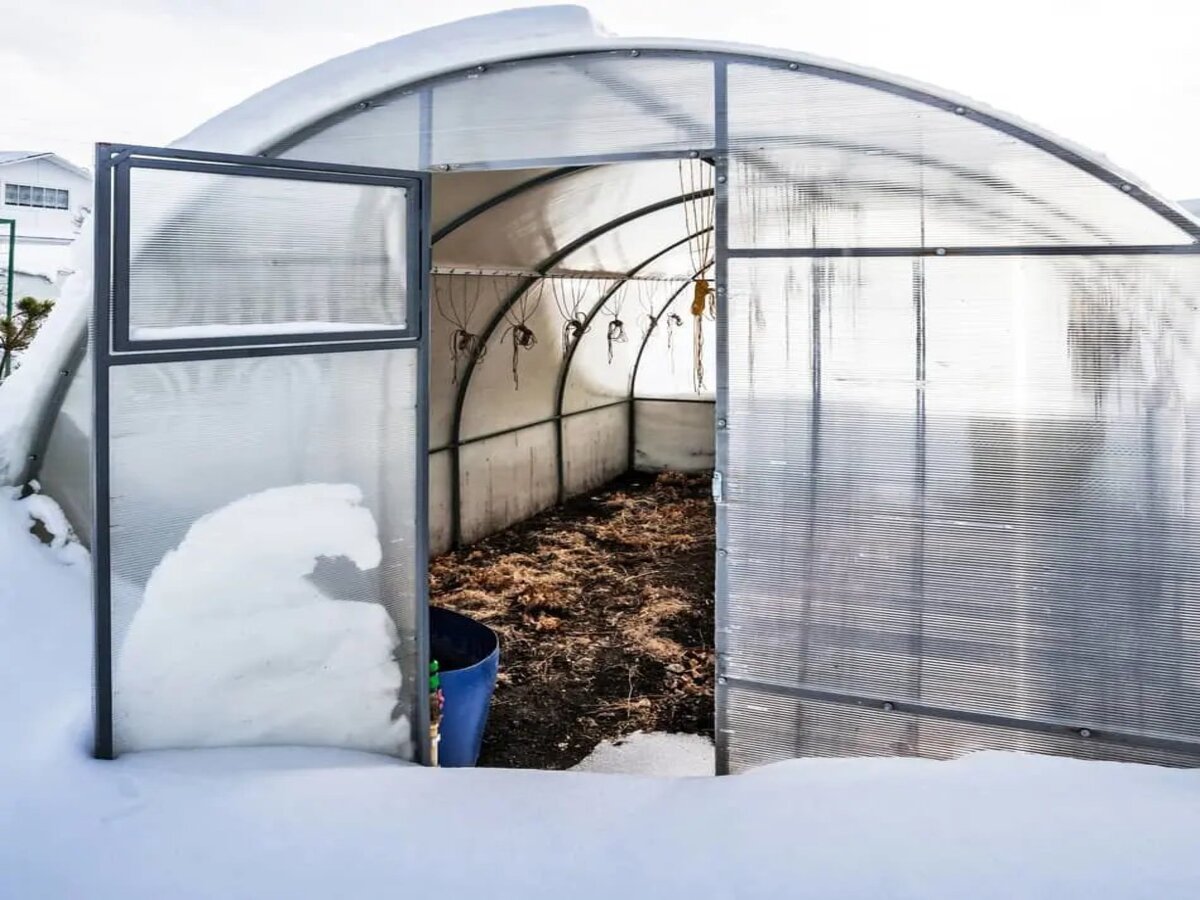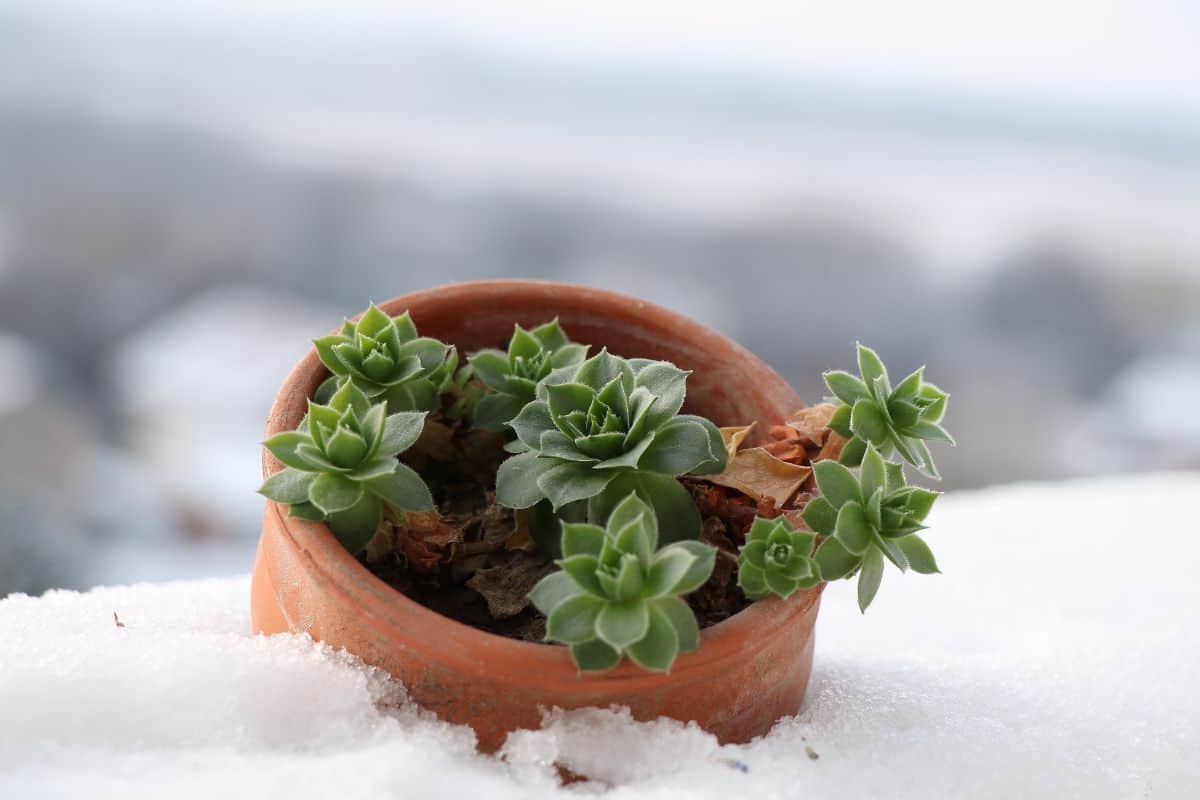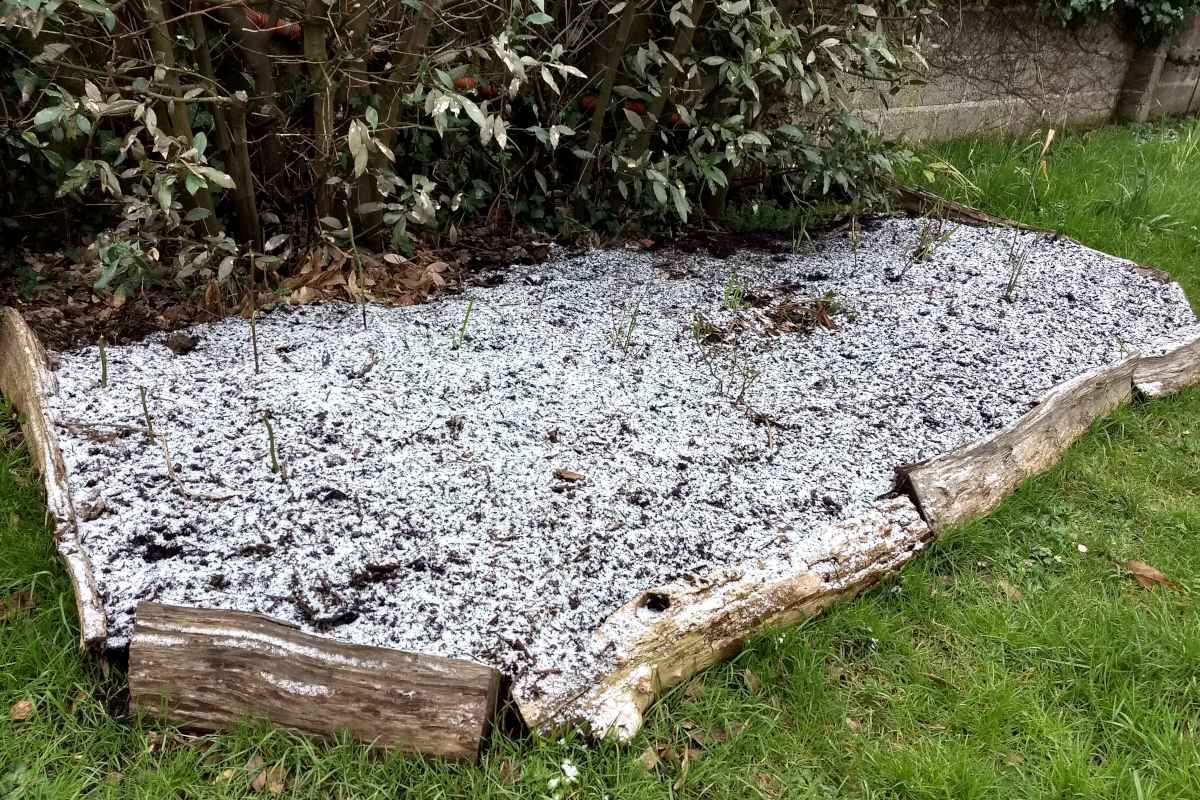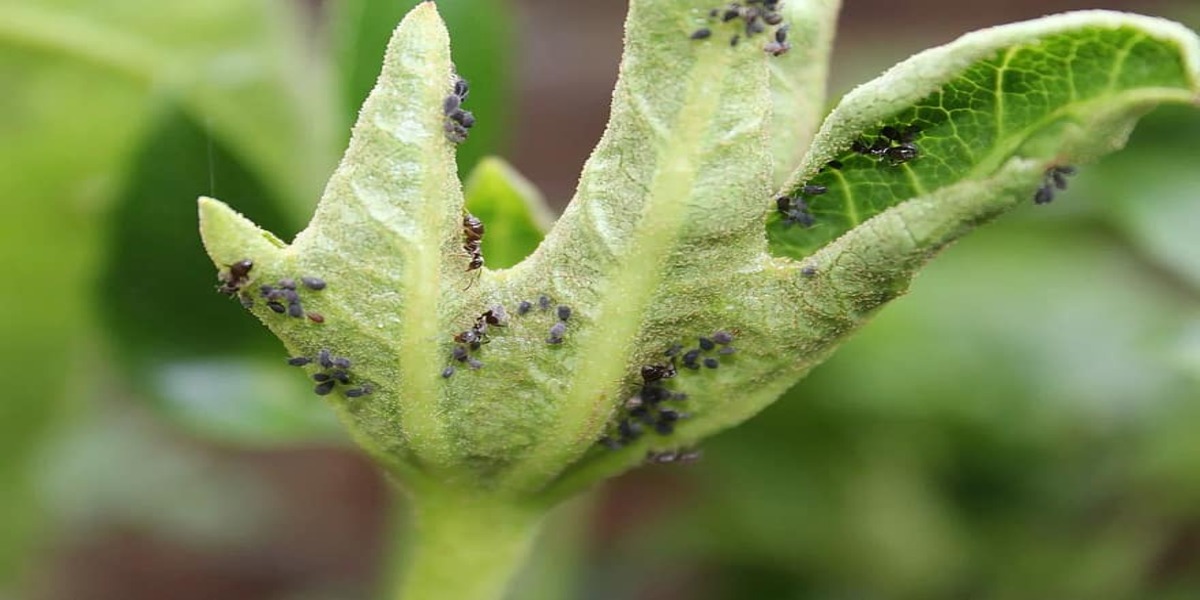Home>Gardening Techniques>How Warm Does A Greenhouse Get In Winter


Gardening Techniques
How Warm Does A Greenhouse Get In Winter
Modified: January 22, 2024
Discover how warm a greenhouse can get during the winter with seasonal gardening tips. Maximize your year-round growing potential with effective temperature control.
(Many of the links in this article redirect to a specific reviewed product. Your purchase of these products through affiliate links helps to generate commission for Chicagolandgardening.com, at no extra cost. Learn more)
Table of Contents
- Introduction
- Understanding Greenhouses
- Factors Affecting Winter Temperatures in Greenhouses
- Types of Greenhouse Heating Systems
- Managing Greenhouse Temperatures in Winter
- Controlling Humidity in Winter Greenhouses
- Potential Benefits and Challenges of Maintaining Warm Temperatures in Winter Greenhouses
- Conclusion
Introduction
Welcome to the wonderful world of seasonal gardening! As the seasons change, so do the opportunities and challenges that come with tending to your garden. Each season presents unique conditions that impact plant growth and require specific care and attention. In this article, we will explore the fascinating realm of seasonal gardening, focusing specifically on the joys and intricacies of gardening during the winter months.
Winter gardening can be a rewarding experience, as it allows you to continue nurturing your green thumb even when the temperatures drop and the days shorten. While many assume that winter is a time of dormancy for plants, skilled gardeners know that there are plenty of crops and plants that thrive during this time.
Whether you have a small backyard garden, a greenhouse, or even just a few pots on a balcony, understanding the unique needs of winter gardening can help you make the most of this season. From selecting cold-hardy vegetables to implementing proper winter care techniques, there is a world of possibilities waiting to be explored.
Throughout this article, we will delve into the best practices for winter gardening, aiding you in keeping your plants healthy and vibrant even in the harshest of winter conditions. We will discuss the importance of understanding the specific requirements of different plants, as well as the significance of temperature, light, and moisture management.
So, if you’re ready to dig into the captivating world of seasonal gardening and embark on an exciting winter gardening journey, read on. Whether you’re a beginner or a seasoned gardener, this article will provide you with valuable insights and practical tips to help you make the most of your winter gardening endeavors.
Understanding Greenhouses
Greenhouses are a valuable asset for any gardener, providing a controlled environment that allows for year-round gardening. These structures are designed to capture and retain solar heat, creating a warm and nurturing space for plants even during the cold winter months.
A greenhouse works by utilizing the greenhouse effect, where the sun’s rays penetrate the glass or plastic walls, heating the air and ground inside. This trapped heat creates a microclimate within the greenhouse, allowing plants to thrive even when it’s freezing outside.
There are various types of greenhouses, ranging from small, simple structures to large commercial operations. The choice of greenhouse will depend on factors such as available space, budget, and specific gardening needs. Some popular types of greenhouses include freestanding, attached, and lean-to designs.
Greenhouses come in different materials, with glass and polycarbonate being the most common. Glass provides excellent light transmission and durability, while polycarbonate is lighter and offers better insulation properties. Both materials have their advantages and it’s important to consider factors such as climate and budget when selecting the right material for your greenhouse.
In addition to providing a protective structure, greenhouses often incorporate ventilation systems to regulate temperature and air circulation. This is particularly important during the winter months when maintaining optimal growing conditions can be a challenge. Ventilation helps prevent heat build-up and humidity issues, reducing the risk of diseases and pests.
Understanding the basic principles of greenhouse operation is crucial for successful winter gardening. By harnessing the power of sunlight and creating a controlled environment, you can extend your gardening season and grow a wider variety of plants. However, it’s important to remember that each greenhouse is unique, and factors such as insulation, orientation, and ventilation will affect its ability to maintain temperature and humidity levels.
In the next section, we will explore the factors that affect winter temperatures in greenhouses and discuss strategies to manage and control these variables to create an optimal growing environment for your winter garden.
Factors Affecting Winter Temperatures in Greenhouses
When it comes to maintaining ideal temperatures in winter greenhouses, several factors come into play. Understanding these factors will help you create the optimal environment for your plants and ensure their healthy growth throughout the cold season.
1. Insulation: The level of insulation in your greenhouse plays a vital role in temperature regulation. Properly insulated walls, roof, and flooring can help retain heat and prevent cold drafts. Consider materials such as double-paned glass or bubble wrap to improve insulation and reduce heat loss.
2. Orientation: The orientation of your greenhouse affects the amount of sunlight it receives. Ideally, a south-facing orientation will maximize sunlight exposure during the winter months when the sun is lower in the sky. Proper orientation ensures that plants receive sufficient light and warmth to thrive.
3. Ventilation: Good ventilation is essential for controlling temperature and humidity levels. Adequate airflow prevents overheating during sunny days and reduces condensation buildup, which can lead to fungal diseases. Adjusting vents, using fans, and installing louvers can help maintain optimal air circulation.
4. Heat Source: Having a reliable heat source is crucial for keeping temperatures stable in winter greenhouses. Consider using electric heaters, radiant floor heating, or even geothermal systems depending on the size and needs of your greenhouse. Insulated heating cables can be used for root-zone heating, promoting growth and preventing cold damage to plant roots.
5. Outside Temperature: The external temperature is a significant factor influencing the temperature inside your greenhouse. Keep track of weather forecasts to anticipate temperature fluctuations and make adjustments accordingly. Installing a maximum-minimum thermometer inside the greenhouse will help monitor temperature variations.
6. Thermal Mass: Thermal mass refers to materials that absorb and slowly release heat, providing a buffer against temperature fluctuations. Incorporating thermal mass elements such as water barrels or stone walls into your greenhouse design can help regulate temperature by absorbing excess heat during the day and releasing it when temperatures drop.
7. Shade Cloth: During particularly sunny winter days, a shade cloth can be used to prevent excessive heat buildup. By reducing the intensity of sunlight entering the greenhouse, you can maintain more moderate temperatures and prevent plant stress or damage.
By considering these factors and implementing appropriate strategies, you can create a winter greenhouse environment that provides the optimal conditions for your plants. In the next section, we will explore different types of greenhouse heating systems that can be used to maintain warmth during the coldest months of the year.
Types of Greenhouse Heating Systems
When it comes to heating your greenhouse during winter, you have several options to choose from. The type of heating system you select will depend on factors such as the size of your greenhouse, your budget, and the fuel availability in your area. Let’s explore some common greenhouse heating systems:
1. Gas or Oil Furnaces: Gas or oil furnaces are popular choices for larger greenhouses. They provide efficient and consistent heat distribution, ensuring that the temperature remains stable. These systems are typically equipped with automatic thermostats and can be fueled by natural gas, propane, or heating oils.
2. Electric Heaters: Electric heaters are a convenient option for smaller greenhouses or areas where gas or oil may not be readily available. These heaters come in various sizes and can provide localized heat distribution. Electric heaters are easy to install and offer precise temperature control.
3. Boiler Systems: Boiler systems use hot water or steam to heat a greenhouse. The hot water or steam is circulated through pipes, radiators, or under-the-bench systems to warm the air. Boiler systems can be fueled by natural gas, propane, or wood, offering flexibility in fuel choices.
4. Radiant Floor Heating: Radiant floor heating is an efficient and evenly distributed heating method. It involves installing a system of pipes beneath the greenhouse floor, through which hot water or steam flows. The heated floor then radiates heat throughout the greenhouse, keeping plants warm and promoting optimal growth.
5. Biomass Furnaces: Biomass furnaces burn organic materials such as wood pellets, corn, or agricultural waste to produce heat. These systems are environmentally friendly, as they utilize renewable resources. Biomass furnaces require a dedicated space for fuel storage and need regular maintenance to ensure optimal performance.
6. Solar Heating: Solar heating harnesses the power of the sun to warm the greenhouse. It involves installing solar panels or collectors to capture solar energy that is then used to heat the greenhouse. Solar heating systems can be combined with other heating methods for more consistent temperature regulation, especially during cloudy days or nighttime.
Each heating system has its advantages and considerations, so it’s important to evaluate your specific needs and resources before making a decision. Consider factors such as cost, efficiency, fuel availability, and environmental impact when selecting the heating system that best suits your winter greenhouse requirements.
In the next section, we will explore strategies for managing greenhouse temperatures during winter, regardless of the heating system you choose.
Managing Greenhouse Temperatures in Winter
Maintaining optimal temperatures in your greenhouse during the winter months is crucial for the health and productivity of your plants. Here are some effective strategies to help you manage greenhouse temperatures:
1. Insulation: Insulating your greenhouse is key to reducing heat loss. Use materials such as bubble wrap, polyethylene sheets, or double-layered glazing to create a barrier between the inside and outside temperatures. Insulate the walls, roof, and even the entrance to minimize heat escape and prevent cold drafts.
2. Thermometers and Sensors: Install thermometers and environmental sensors throughout your greenhouse to monitor temperature and humidity levels. This will help you make adjustments and ensure that conditions remain within the desired range. Consider using wireless or Bluetooth-enabled devices for convenient monitoring.
3. Ventilation: Proper ventilation is essential for regulating temperatures and humidity. Open vents or windows during warm periods to release excess heat and moisture. Install exhaust fans to facilitate air circulation and prevent stagnant air pockets. Automatic vent openers can be used to regulate airflow without constant manual adjustments.
4. Shade Cloth: During sunny winter days, use shade cloth to diffuse and reduce the intensity of sunlight. This will help prevent overheating and excessive temperature fluctuations. Shade cloth can be easily installed and removed as needed to strike the right balance between light and heat control.
5. Thermal Mass: Utilize thermal mass materials to absorb and release heat slowly. Water barrels, bricks, or concrete can absorb excess heat during the day and release it at night when temperatures drop. Place thermal mass objects strategically around your greenhouse to provide temperature stability and prevent rapid fluctuations.
6. Heating Zones: Divide your greenhouse into heating zones to efficiently manage temperature requirements for different plants. More cold-sensitive plants can be grouped in the warmest zone, while hardier plants can tolerate cooler temperatures. This zoning allows you to adjust heating levels more precisely and conserve energy.
7. Cold Frames: Extend your growing space by incorporating cold frames into your greenhouse design. Cold frames act as mini-greenhouses within the main structure and provide an additional layer of insulation. They are ideal for overwintering potted plants or cultivating cold-loving crops directly in the ground.
8. Monitoring and Adjusting: Regularly monitor temperature and humidity levels in your greenhouse. Adjust your heating system or ventilation settings as needed to maintain the optimal range for your plants. Be mindful of external weather conditions and make necessary changes to accommodate temperature fluctuations.
By employing these strategies, you can create a stable and comfortable environment for your plants, ensuring their health and productivity throughout the winter season. Now let’s explore the importance of managing humidity levels in winter greenhouses.
Controlling Humidity in Winter Greenhouses
Humidity management is a critical aspect of maintaining a healthy and thriving environment in your winter greenhouse. Proper humidity levels are essential for optimal plant growth and to prevent the development of fungal diseases. Here are some strategies to effectively control humidity in your winter greenhouse:
1. Ventilation: Adequate ventilation is key to regulating humidity levels. Good airflow helps to remove excess moisture, preventing condensation and reducing the risk of fungal growth. Implementing a ventilation system with adjustable vents, fans, or louvers allows you to control the amount of air exchange to maintain the desired humidity level.
2. Drip Irrigation and Watering Practices: Be mindful of your watering practices to minimize excess humidity. Avoid overwatering and ensure proper drainage to prevent water from accumulating in the greenhouse. Consider using drip irrigation systems that directly target the root zone of plants, minimizing water contact with foliage and reducing overall humidity levels.
3. Dehumidifiers: Installing dehumidifiers can be an effective solution in high-humidity environments. Dehumidifiers extract moisture from the air, helping to control humidity levels and prevent excessive moisture buildup. Choose a dehumidifier with a capacity appropriate for the size of your greenhouse for optimal results.
4. Heating and Temperature Control: Maintaining appropriate temperatures can indirectly help manage humidity. Warmer air has a higher capacity to hold moisture, reducing the likelihood of condensation. Properly managing your greenhouse’s heating system to maintain consistent temperatures will help regulate humidity levels and prevent excessive moisture accumulation.
5. Mulching and Soil Management: Mulching the soil surface can help prevent evaporation and moisture loss, thereby reducing humidity levels. Additionally, using well-draining soil mixes and adequately spacing plants can improve air circulation and minimize moisture retention in the greenhouse.
6. Humidity Monitors: Utilize humidity monitors or hygrometers to accurately measure and monitor humidity levels in your greenhouse. These devices will help you identify fluctuations and determine the effectiveness of your humidity control strategies. Adjust your practices accordingly based on the readings to maintain a healthy humidity range.
7. Proper Cleaning and Sanitization: Regularly clean and sanitize your greenhouse to minimize the chance of fungal or bacterial infestations. Remove any debris or dead plant material that could harbor moisture and promote the growth of pathogens. A clean and well-maintained greenhouse will contribute to better humidity control.
By implementing these moisture management strategies, you can create a balanced humidity environment in your winter greenhouse. Monitoring humidity levels, adjusting ventilation, and practicing appropriate watering techniques will help facilitate optimal plant growth and prevent the onset of humidity-related issues.
Next, we will explore the potential benefits and challenges of maintaining warm temperatures in winter greenhouses.
Potential Benefits and Challenges of Maintaining Warm Temperatures in Winter Greenhouses
Maintaining warm temperatures in your winter greenhouse has several potential benefits for your plants, but it also presents some challenges that need to be considered. Let’s explore both the advantages and difficulties associated with keeping your greenhouse warm during the winter months.
Benefits:
1. Extended Growing Season: By providing a warm and regulated environment, you can extend your growing season significantly. This means you can continue growing vegetables, herbs, and even some flowers when it would typically be too cold to do so. This allows for a continuous supply of fresh produce and the opportunity to experiment with different plant varieties.
2. Increased Crop Variety: With a warm greenhouse, you have the opportunity to grow a wider range of crops. You can experiment with tropical or semi-tropical plants that wouldn’t survive the outdoor winter conditions in your area. This expands your gardening possibilities and enables you to diversify your harvest.
3. Protection from Frost and Cold Damage: A warm greenhouse provides a protective shield against frost and extreme cold temperatures. By maintaining a stable and elevated temperature inside, you can shield delicate plants from freezing temperatures, preventing damage to leaves, fruits, and flowers. This protection helps safeguard your plants and ensures their survival during harsh winter weather.
4. Controlled Environment: A warm greenhouse allows you to have greater control over the growing conditions. You can fine-tune factors such as temperature, humidity, and light to meet the specific needs of your plants. This level of control enhances plant growth, promotes better yields, and enables you to create an ideal microclimate for your desired crops.
Challenges:
1. Energy Costs: Maintaining warm temperatures in the winter can significantly increase energy costs, especially in larger or poorly insulated greenhouses. Heating systems, ventilation, and lighting may consume considerable amounts of energy, impacting your overall expenses. It’s important to factor in the cost of heating when planning and budgeting for your winter greenhouse operations.
2. Temperature Regulation: Consistently maintaining the desired temperature can be challenging. External factors, such as fluctuating outdoor temperatures, can impact the indoor climate, requiring frequent adjustments to your heating and ventilation systems. This constant monitoring and regulation can be time-consuming and may require manual intervention in response to changing weather conditions.
3. Humidity Management: Creating and maintaining warm temperatures in a closed environment can result in increased humidity levels. High humidity can lead to condensation, increased risk of fungal diseases, and reduced airflow. Effectively managing humidity becomes crucial to prevent plant stress or the spread of moisture-related issues.
4. Pest and Disease Management: Warm and humid conditions can create an ideal environment for pests and diseases to thrive. In a warm greenhouse, pests such as aphids, mealybugs, and spider mites may become more active. Fungal diseases, such as powdery mildew or botrytis, can also spread more easily in the warm and humid environment. Vigilance and proactive pest and disease management practices are essential to keep your plants healthy.
Overall, the benefits of maintaining warm temperatures in a winter greenhouse can outweigh the challenges with proper planning and management. By understanding and addressing the potential difficulties, you can create a favorable environment for your plants to thrive, allowing you to enjoy fresh produce and gardening satisfaction throughout the winter season.
Finally, let’s conclude our exploration of seasonal gardening in winter greenhouses.
Conclusion
As we conclude our journey into the realm of seasonal gardening in winter greenhouses, we hope you now have a deeper understanding of the intricacies and possibilities that lie within this unique gardening endeavor. Winter gardening offers a chance to extend your growing season, experiment with new crops, and maintain your love for gardening even during the coldest months.
By understanding the factors that affect winter temperatures in greenhouses, such as insulation, orientation, and ventilation, you can create a nurturing environment that promotes healthy plant growth. Choosing the right heating system and implementing effective strategies for managing temperatures and humidity will help you create an optimal growing environment for your plants.
There are both benefits and challenges associated with maintaining warm temperatures in winter greenhouses. On one hand, you can enjoy an extended growing season, increased crop variety, and protection from frost and cold damage. On the other hand, you need to consider the energy costs, temperature regulation, humidity management, and pest control strategies required to create and maintain a thriving greenhouse ecosystem.
Despite the challenges, the rewards of winter gardening are undeniable. The joy of seeing your plants flourish, harvesting fresh produce during the cold months, and nurturing your green thumb year-round make it all worthwhile. With dedication, knowledge, and the right tools, you can create an oasis of life and growth inside your winter greenhouse.
So, whether you’re a seasoned gardener looking to expand your gardening horizons or a beginner embracing the wonders of winter gardening, we encourage you to embrace the opportunities and challenges that this season brings. With the right approach and a little bit of nature’s magic, your winter greenhouse will become a haven of beauty, abundance, and satisfaction.
Now, go forth and embark on your winter gardening journey. Embrace the joys of seasonal gardening, nurture your plants, and create a winter wonderland of green in your very own greenhouse.






